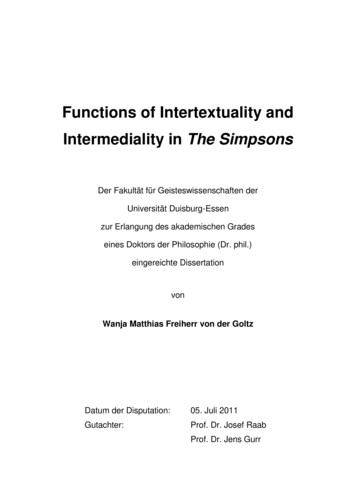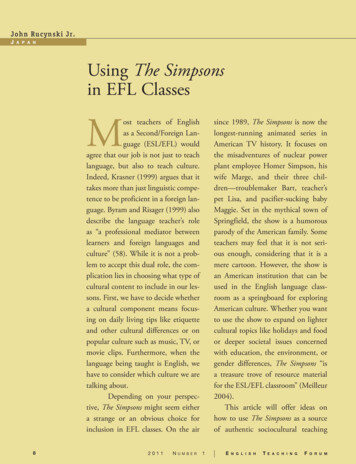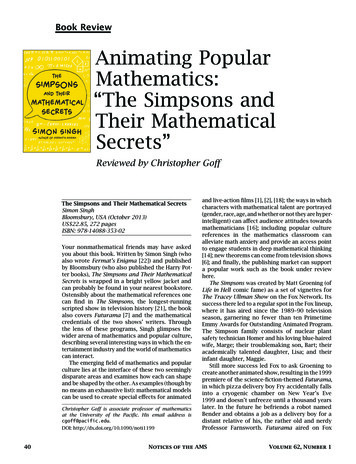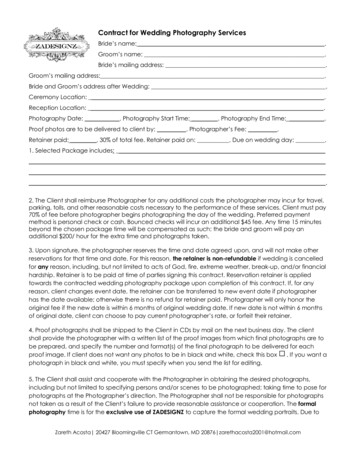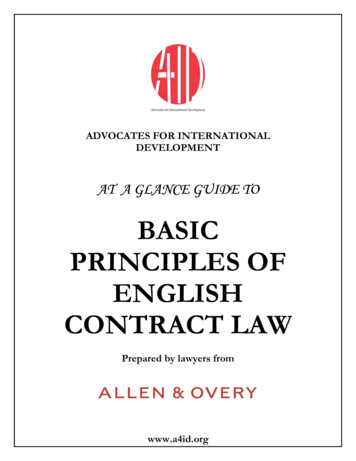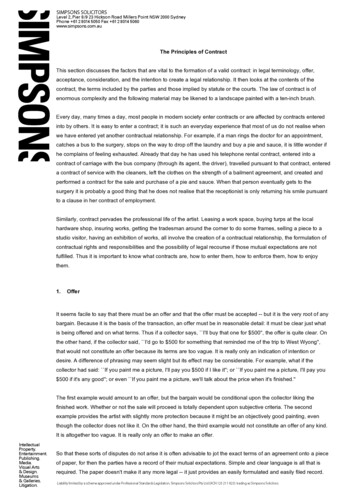
Transcription
The Principles of ContractThis section discusses the factors that are vital to the formation of a valid contract: in legal terminology, offer,acceptance, consideration, and the intention to create a legal relationship. It then looks at the contents of thecontract, the terms included by the parties and those implied by statute or the courts. The law of contract is ofenormous complexity and the following material may be likened to a landscape painted with a ten-inch brush.Every day, many times a day, most people in modern society enter contracts or are affected by contracts enteredinto by others. It is easy to enter a contract; it is such an everyday experience that most of us do not realise whenwe have entered yet another contractual relationship. For example, if a man rings the doctor for an appointment,catches a bus to the surgery, stops on the way to drop off the laundry and buy a pie and sauce, it is little wonder ifhe complains of feeling exhausted. Already that day he has used his telephone rental contract, entered into acontract of carriage with the bus company (through its agent, the driver), travelled pursuant to that contract, entereda contract of service with the cleaners, left the clothes on the strength of a bailment agreement, and created andperformed a contract for the sale and purchase of a pie and sauce. When that person eventually gets to thesurgery it is probably a good thing that he does not realise that the receptionist is only returning his smile pursuantto a clause in her contract of employment.Similarly, contract pervades the professional life of the artist. Leasing a work space, buying turps at the localhardware shop, insuring works, getting the tradesman around the corner to do some frames, selling a piece to astudio visitor, having an exhibition of works, all involve the creation of a contractual relationship, the formulation ofcontractual rights and responsibilities and the possibility of legal recourse if those mutual expectations are notfulfilled. Thus it is important to know what contracts are, how to enter them, how to enforce them, how to enjoythem.1.OfferIt seems facile to say that there must be an offer and that the offer must be accepted -- but it is the very root of anybargain. Because it is the basis of the transaction, an offer must be in reasonable detail: it must be clear just whatis being offered and on what terms. Thus if a collector says, I'll buy that one for 500'', the offer is quite clear. Onthe other hand, if the collector said, I'd go to 500 for something that reminded me of the trip to West Wyong'',that would not constitute an offer because its terms are too vague. It is really only an indication of intention ordesire. A difference of phrasing may seem slight but its effect may be considerable. For example, what if thecollector had said: If you paint me a picture, I'll pay you 500 if I like it''; or If you paint me a picture, I'll pay you 500 if it's any good''; or even If you paint me a picture, we'll talk about the price when it's finished.''The first example would amount to an offer, but the bargain would be conditional upon the collector liking thefinished work. Whether or not the sale will proceed is totally dependent upon subjective criteria. The secondexample provides the artist with slightly more protection because it might be an objectively good painting, eventhough the collector does not like it. On the other hand, the third example would not constitute an offer of any kind.It is altogether too vague. It is really only an offer to make an offer.So that these sorts of disputes do not arise it is often advisable to jot the exact terms of an agreement onto a pieceof paper, for then the parties have a record of their mutual expectations. Simple and clear language is all that isrequired. The paper doesn't make it any more legal -- it just provides an easily formulated and easily filed record.
Most offers may be withdrawn at any time up until they are accepted. Or, the offer may be made for a limited periodand at the end of that period it will automatically extinguish ( I'll buy that painting for 500 . . . You've got 'tilFriday''). It is also extinguished by any counter-offer. Thus if a collector offers 500 for a piece (offer), and the artistsays You can have it for 650'' (counter-offer), it is an implicit rejection of the original offer and destroys it. If theparties eventually settle on 500, that would involve the acceptance of another, newly made offer: Hyde v. Wrench(1840) 49 E.R. 132; Baker v. Taylor (1906) 6 S.R. (N.S.W.) 500.Sometimes, what looks like an offer capable of acceptance, is not. It is merely an indication of preparedness tonegotiate. For example, if a gallery exhibits a painting and beside it places a little card detailing the artist's name,the work's title, and the price, that does not constitute an offer to sell that work at that price. It is merely an offer tonegotiate, akin to an advertisement. If the collector goes to the gallery owner and says I'll take it!'', he or she is notaccepting a standing offer. Rather the collector is making an offer to buy the work at the listed price. The owner canaccept or reject that offer!2.AcceptanceAcceptance is achieved by showing the person making the offer that the terms of the offer are agreed to. This maybe done orally, in writing, or even implied from conduct (usually by doing the thing required). The latter mode ishazardous and an artist should seek or give at least oral acceptance of an offer.The acceptance must be communicated to the offeror; it cannot be inferred from silence: Felthouse v. Bindley(1862) 142 E.R. 1037.3.ConsiderationConsideration is the feature that distinguishes a bargain from a gift. It is the price, not necessarily in money terms,that each party asks of the other in return for entering the agreement. This is important because, in order to enforcea contract, a party has to show that he or she paid a price. This can be done in one of two ways:1.It may be shown that at the time of the alleged bargain, one party offered a promise if the other party was to doan act. For example, I'll pay you 500 when you paint my portrait.'' In this example, one party givesconsideration by making a promise, and the other will provide consideration by painting the portrait.2.It may be shown that at the time the bargain was reached, each party was to give a promise in exchange forthe other's promise. For example, I'll give you 500 if you paint my portrait.'' O.K. I'll do it!'' In this example,the consideration is construed as a promise in return for a promise. Each is consideration for the other.Similarly, a person might offer an artist 500 not to paint a certain subject. The promise of 500 would beconsideration from the one, and the promise to refrain would be consideration from the other.
The exchange does not have to be even, for the law will not inquire into the relative values of the consideration;one party might provide an enormous sum of money, another might give a promise, and still another might providea proverbial peppercorn. The important thing is that each has given the other the required price.It is also crucial that the consideration not be past. Thus if a collector buys a work and then says to the artist that heenjoys the work so much that he is going to give him an additional 500, that promise is unenforceable becausethe only consideration that the artist has provided (the painting) is past. The law does not recognise the continuingpleasure given by the work to be of actual value. The promise to pay the extra money would be only a promise of agift (for the consideration is one sided) and therefore unenforceable.4.Intention to Create a Legal RelationshipIf a promise is to be enforceable it must be shown that it was intended to be a legally binding commitment. Thisexcludes merely domestic arrangements such as promises to pay pocket-money or house-keeping money, forthese are to be enforced in the kitchen rather than the courtroom.In contrast, agreements of a commercial nature are presumed by the courts to be entered with the intention ofcreating a legal, enforceable relationship. This presumption is particularly important in the artist- gallery relationshipbecause so many galleries do not have written contracts with the artists they represent. Contrary to the commonlyheld belief, this does not necessarily mean that there is no contractual relationship between them; so long as theterms of their relationship are sufficiently clear (offer and acceptance), the court would not hesitate to find that theparties had intended to enter a legal, and therefore enforceable, contract. If the court's jurisdiction is to beexcluded, very particular proof of that intention is required.5.Contents of the ContractNot everything contained in a contract is necessarily a term of the contract. Some matters are classified as mererepresentations'' and are not enforceable. For example, if a person says, I will sell you this very fine WalterWithers for 10,000'', the phrase very fine'' would not be considered a term of the contract. Rather it would betreated as a promotional puff. On the other hand, the fact that the painting was by Withers and that the price was 10,000 would be treated as terms of the agreement. It is not always easy to distinguish between terms and mererepresentations, but one may ask oneself, Would it appear to a reasonable onlooker, that the party wasguaranteeing the truth of the statement?'' If the answer is yes the statement is a term of the contract.The two most important types of term are conditions and warranties. Naming them is easy but accuratelydescribing them is not. For centuries, judges have battled with the definitional problem without reaching anyapparent consensus. Difficult as it may be, the problem is an important one because the breach of a conditionpermits the disappointed party to rescind the contract, whereas the breach of a warranty only permits that party tosue for damages to make up for any loss that has been suffered. Lord Upjohn has suggested that one should askwhether the breach of the stipulation goes so much to the root of the contract that it makes further commercialperformance impossible: Hong Kong Fir Shipping Co. v. Kawasaki Kisen Kaisha Ltd [1962] 2 Q.B. 26 at 64. On theother hand, the High Court in Associated Newspapers Ltd v. Bancks (1951) 83 C.L.R. 322 at 336-367 suggested
that a condition was a term without which the parties would not have entered the contract. The facts of that caseprovide an interesting example of the condition-warranty problem.The defendant Bancks was the creator of Ginger Meggs'', a well- known cartoon character. The artist contractedwith the newspaper to supply every week, for ten years, a full page of Us Fellers''. In return, one of the promisesmade by the newspaper was that the work would be published on the front page of the comic section. For threeSundays in a row the strip appeared on page three, so Bancks hung up his pencil. In the case that followed, theHigh Court (!) decided that unless the newspaper had offered front page status to Bancks, the artist would not haveentered the contract. Thus that term could be characterised as a condition, the newspaper had breached thatcondition, and Bancks was entitled to treat the contract as at an end.What this case illustrates is that whether a term is called a condition or a warranty will depend on the judicialconstruction accorded it. If the parties wish to make it clear that the breach of particular terms of the contractshould permit termination of the agreement, they should not simply call those terms, conditions'', and the others, warranties''. The court will not consider itself bound by such a quixotic foray into the definitional problems of thelaw of contract. But if the parties spell out the effect of such breach, rather than merely labelling it, the court willgive effect to that declared intention.6.Terms Implied by StatuteThe Commonwealth and every State government has statutes which impose duties upon manufacturers andsellers of products. These apply to works of art and craft just as much as to any other products.These statutes have effect in numerous ways but all of them are basically consumer protection provisions. Someimply terms into the contract, others impose liability even in the absence of a contract. This latter approach is bothexceptional and useful for it avoids the problems caused by the doctrine of privity of contract.For example, under the common law where a retailer sold an item to a purchaser, it could not be argued that therewas any contractual duty owed by the manufacturer to the purchaser. The relationship was simply between thepurchaser and the seller. If there was anything wrong with the goods the purchaser's recourse, if any, was againstthe seller. Now, thanks to statutory intervention in some jurisdictions, where goods are sold retail, the manufacturerwarrants to the purchaser that the goods are of merchantable quality even though there is no privity between them.Thus an artist (the manufacturer) warrants a private collector (the purchaser) that the works (the goods) are ofmerchantable quality: see Sale of Goods Act (N.S.W.) 1923, s. 64(5); Hire-Purchase Act 1960 (N.S.W.);Manufacturers' Warranties Act 1974 (S.A.); Manufacturers' Warranties Ordinance 1975 (A.C.T.); Trade PracticesAct 1975 (Cth), Pt V, Div. 2A.6.1Conformity with descriptionA sale by description occurs when a seller describes goods to the buyer and the buyer purchases them on thestrength of that description. In such a case there is a statutorily implied term that the goods will in fact correspondto the description. However the term will be implied only if the non-compliance goes to the identity of the goods,rather than their quality. For example, if an artist buys a tube of paint the label of which reads ochre'' and takes it
home only to find
The exchange does not have to be even, for the law will not inquire into the relative values of the consideration; one party might provide an enormous sum of money, another might give a promise, and still another might provide
